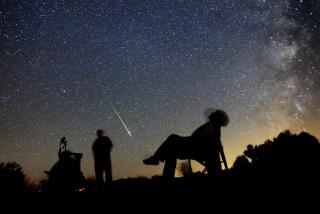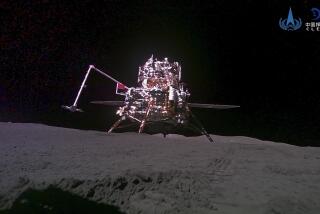Man Is Aglow Over Moon Rock in His Big Collection
- Share via
TUCSON — Robert A. Haag owns a piece of the moon, and he may be the only person in the world who does.
Haag is a 35-year-old entrepreneur who has amassed what experts consider the best and largest private collection of meteorites anywhere on the globe, some of which he sells to collectors around the world. While adding to his collection in Australia a year ago, Haag came across a tiny specimen that looked different.
He filed off one edge of the 19-gram stone and “I knew immediately it was lunar,” he said in the huge vault beneath his home on the outskirts of Tucson, where he keeps his collection of thousands of meteorites.
“I almost passed out,” he said. “It was mine.”
Haag sliced off a small piece of the meteorite and took it to the Lunar and Planetary Laboratory at the University of Arizona. The lab had determined several years ago that a dozen rare meteorites found in Antarctica had come from the surface of the moon.
Researchers Dolores H. Hill and William V. Boynton were astonished when they found that the meteorite was rich in lunar materials and contained a ratio of certain chemicals that “leave no doubt whatsoever that this is lunar,” Hill said in a statement released Wednesday by the university.
Hill and Boynton are publishing their findings in today’s issue of the British journal Nature.
The meteorite is the only lunar rock found on the Earth outside of Antarctica, and it got here the same way as those specimens, although not necessarily from the same event. Meteorites in general are easier to find in areas--such as Antarctica--that have not been cultivated and do not have extensive vegetation or urbanization.
Lunar meteorites are created when another celestial body--possibly a small asteroid--collides with the moon so violently that debris is sent flying off into space; some being captured by the Earth’s gravity. In this case, one meteorite landed in the Australian outback, where it remained unmolested for years in a region known to be rich with meteorites.
The only lunar meteorites found before Haag’s were those discovered in Antarctica several years ago, and they belong to the governments of the United States and Japan. Haag, a self-taught expert who got interested in meteorites when his parents ran a rock shop in Tucson, has the only one in private hands.
With long hair cascading down over his shoulders, Haag looks more like a rock star than a rock collector. He said he has not decided what to do with his meteorite yet, but he believes it is worth a fortune.
The discovery is the second major turning point in his life in as many years. The first was when he got arrested in Argentina.
Haag had purchased a 37-ton meteorite, one of the largest in the world, from a source in Argentina, where he had collected samples during four previous trips. Unfortunately, it turned out that the person who sold him the rock had no right to do so.
“It was the classic case of someone selling the Brooklyn Bridge,” said one source who is familiar with the case.
Haag found out about his problem while trying to cross out of Chaco Province.
“The police said . . . ‘This is a national treasure,’ ” Haag said. “I couldn’t very easily say, ‘What rock?’ because it was strapped on top of a truck.”
So Haag spent six days in jail while the matter was sorted out. Eventually, it was termed a “misunderstanding.”
News accounts spread around the world, and Haag said his business just boomed.
“It was the best thing that could have happened to me,” he said. “Last year we grossed over $1 million” by selling meteorites.
As his business has prospered, Haag has become more the businessman, and less the rock hound, while others do the searching for him.
Haag did not actually find the lunar meteorite himself. It was one of hundreds of rocks turned over to him by local Aborigines who were hired to search for rocks for the American.
While going through that massive pile of rocks, Haag noticed that the lunar rock was a little different. As the university’s Hill noted, only someone who has seen thousands of meteorites would have noticed the difference.
The meteorite, which to an untrained eye looks like a boring, rounded, dark pebble, had tiny gas vesicles on its thin crust.
The university’s lab examined the specimen for elements known as KREEP, which stands for potassium (K), rare earth elements (REE) and phosphorus (P). The KREEP pattern is thought to be unique to the moon. The lab found that Haag’s sample contained 20% KREEP elements. That matched the lunar rocks collected by astronauts during the Apollo program.
The meteorite also contained the ratio of iron to manganese known to exist on the moon, and that, coupled with the KREEP pattern, proved convincing.
The age of the meterorite cannot be determined without destroying it.
Collectors are known to pay high premiums for rare meteorites, and Haag has the rarest one in private hands.
“Some day,” he said, grinning broadly, “I may sell it.”
More to Read
Sign up for Essential California
The most important California stories and recommendations in your inbox every morning.
You may occasionally receive promotional content from the Los Angeles Times.













